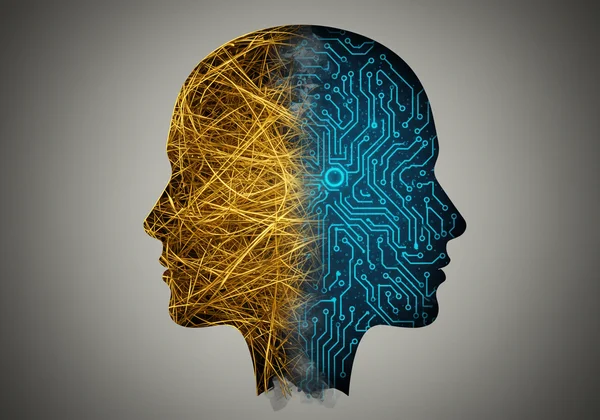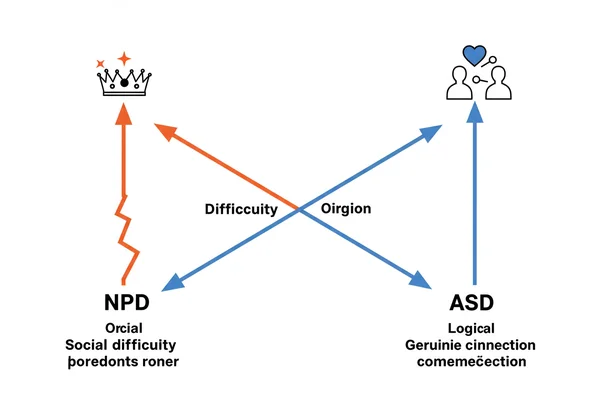NPD vs. Autism: 7 Key Differences & How to Tell Them Apart
Are you struggling to understand certain social behaviors in yourself or a loved one? When researching online, you might find confusing overlaps between conditions like Narcissistic Personality Disorder (NPD) and Autism Spectrum Disorder (ASD). On the surface, traits like social difficulties or an intense focus on specific topics can appear similar. This guide offers a clear, compassionate breakdown of the narcissistic vs. autistic experience to help you understand the core differences and find a path toward clarity. Am I narcissistic or autistic? It's a valid question many people ask, and untangling these threads is the first step toward self-awareness.

It's crucial to remember that only a qualified mental health professional can provide an official diagnosis. However, exploring these traits can be a valuable exercise in self-reflection. If you're looking for a starting point, a well-designed screening tool can offer initial insights. You can begin your self-discovery journey with our confidential NPD screening tool, which is designed to explore specific traits.
Understanding Core Traits: What is Narcissism (NPD)?

Narcissistic Personality Disorder, as defined in the DSM-5-TR, is a personality disorder characterized by a pervasive pattern of grandiosity, a constant need for admiration, and a lack of empathy. At its core, NPD is often driven by a fragile and deeply insecure self-esteem that is masked by an outward display of superiority. This internal vulnerability fuels many of the behaviors associated with the disorder, and understanding this motivation is key to recognizing the signs of NPD.
The Drive for Admiration and Grandiosity
A person with narcissistic traits has an insatiable hunger for validation. This isn't just a desire to be liked; it's a profound need to be seen as superior, special, and unique. This manifests as a grandiose sense of self-importance, where they might exaggerate their achievements, talents, and contributions. They expect to be recognized as exceptional, even without the accomplishments to back it up. This constant pursuit of external praise, known as "narcissistic supply," is essential for stabilizing their fragile self-worth.
Understanding Empathy Impairment in NPD
One of the most defining characteristics of NPD is a significant impairment in empathy. This means they are often unwilling or unable to recognize or identify with the feelings and needs of others. They may view other people as objects or tools to be used to fulfill their own needs. While they can sometimes feign concern or understanding (cognitive empathy) when it serves their interests, they typically lack the genuine, heartfelt emotional connection (affective empathy) that forms the basis of healthy relationships. This is a fundamental disconnect from the emotional experiences of others, not simply a misunderstanding of social rules.
Reaction to Criticism: Narcissistic Injury and Rage
Because their sense of self is so fragile and dependent on external validation, individuals with strong narcissistic traits react very poorly to criticism, no matter how minor or well-intentioned. A perceived slight can trigger what is known as a "narcissistic injury," leading to intense feelings of shame, humiliation, and emptiness. The typical response is narcissistic rage—an explosive fit of anger, defensiveness, or cold, punishing silence designed to demean the person who dared to criticize them and restore their sense of superiority.
Understanding Core Traits: What is Autism (ASD)?

Autism Spectrum Disorder is a neurodevelopmental condition that affects how a person communicates, interacts with others, and experiences the world. Unlike a personality disorder, autism is a difference in brain wiring that has been present since birth. Autistic individuals have unique strengths and face distinct challenges, but their core motivations are fundamentally different from those seen in NPD. Many people search for signs of autism in adults because the condition can present differently than it does in children.
Challenges in Social Communication and Interaction
Autistic individuals often find social communication and interaction challenging. This difficulty stems from processing social information differently, not from a lack of desire for connection. They may struggle to intuitively understand and apply unwritten social rules, body language, sarcasm, and other non-verbal social cues. This can lead to interactions that appear awkward, blunt, or one-sided, but the intention is typically to communicate directly or navigate a confusing social landscape, not to dominate or belittle.
The Nature of Empathy in Autism
The idea that autistic people lack empathy is a harmful myth. In reality, many autistic individuals experience intense affective empathy—they feel others' emotions very deeply, sometimes to an overwhelming degree. This is often referred to as "hyper-empathy." Where they may struggle is with cognitive empathy, or the ability to "read" what someone else is thinking or feeling based on social cues. This can lead to misunderstandings, but it stems from a difference in processing, not a lack of caring. The emotional capacity is there, but expressing and interpreting it can be a challenge. If these distinctions are still unclear, you can always explore narcissistic traits further through a focused screening.
The Importance of Routine and Special Interests
Consistency and routine are often very important to autistic individuals. A predictable environment helps reduce the anxiety and sensory overload that can come from navigating a neurotypical world. They also tend to have deep, passionate "special interests." They may love to learn everything about a specific topic and share that knowledge enthusiastically. This intense focus is a source of joy, comfort, and expertise, not a tool for asserting superiority.
Sensory Sensitivity and Stimming
A core aspect of the autistic experience is a different sensory reality. An autistic person may be hypersensitive (overly sensitive) or hyposensitive (under-sensitive) to sounds, lights, textures, smells, or tastes. This can lead to sensory overload, which is an intensely stressful and overwhelming state. To cope, many autistic individuals engage in "stimming"—self-stimulatory behaviors like rocking, hand-flapping, or humming. This is a self-regulation tool to manage sensory input and anxiety, not a sign of agitation or a bid for attention.
Key Differences: Narcissistic vs. Autistic Traits Compared
While some behaviors can look similar on the surface, their underlying motivations are worlds apart. Understanding this difference in intent is the most critical factor in distinguishing NPD from ASD. The following table breaks down key areas of confusion.

| Trait / Behavior | Narcissistic Personality Disorder (NPD) | Autism Spectrum Disorder (ASD) |
|---|---|---|
| Core Motivation | Driven by a need for external validation, admiration, and to maintain a fragile sense of superiority. | Driven by a desire for genuine connection, understanding, and managing a world that can feel overwhelming. |
| Empathy | Lacks or has impaired affective empathy (can't feel what others feel). May use cognitive empathy to manipulate. | Often has intense affective empathy (feels others' emotions deeply). May struggle with cognitive empathy (reading social cues). |
| Self-Image | Inflated, grandiose, and fragile. Believes they are inherently superior to others and is built on a fantasy. | Fact-based and literal. Often highly self-critical and acutely aware of their own strengths and weaknesses. Prone to imposter syndrome. |
| Response to Criticism | Reacts with "narcissistic rage" or cold fury. Sees criticism as a personal attack that must be punished. | May react with confusion, hurt, or anxiety. Often takes feedback literally and may become defensive due to misunderstanding the social subtext. |
| Conversational Style | Engages in monologues to boast, impress, and keep the focus on themselves. Poor listener. | May "infodump" about special interests out of excitement and a desire to share. May miss cues that the other person is losing interest. |
| Social Difficulties | Stems from a lack of interest in others' feelings and a view of people as tools for their own gain. | Stems from difficulty processing unwritten social rules, interpreting non-verbal cues, and sensory overload. |
| Need for Routine | May demand routines that serve their own comfort and sense of entitlement, often at others' expense. | Relies on routines and predictability to reduce anxiety and prevent sensory overload in a confusing world. |
Finding Your Path to Clarity
The most significant difference between narcissistic and autistic traits lies in intent. Behaviors associated with NPD are driven by an underlying need for validation to protect a fragile ego, while autistic traits stem from fundamental differences in neurological processing and sensory experience. One is rooted in self-preservation through superiority, the other in navigating the world with a different kind of operating system.
Please remember, this guide is for informational purposes and is not a substitute for a professional evaluation by a qualified clinician. Self-diagnosis can be misleading and overlook important nuances. If you are questioning where certain behaviors in yourself or someone else may fall, gaining more objective data is a responsible first step. To better understand if you exhibit traits associated with narcissism, take our free online NPD screening. It is confidential, based on DSM-5-TR criteria, and can provide valuable insights to guide your next steps toward clarity and understanding.
Frequently Asked Questions on NPD and Autism
How do I check if I have NPD?
To check if you have NPD, the only definitive method is a comprehensive evaluation by a qualified mental health professional, such as a psychologist or psychiatrist. However, a reliable starting point is self-exploration using credible resources. An online NPD screening tool, like the one we offer, can help you identify potential traits and patterns of behavior. It's a confidential, pressure-free way to gather information before deciding to seek professional help. Start with our screening tool for a preliminary look.
What are the 9 signs of NPD?
The 9 signs of NPD, as outlined in the DSM-5-TR, provide the clinical criteria for diagnosis. They include: 1) A grandiose sense of self-importance; 2) Preoccupation with fantasies of unlimited success, power, or beauty; 3) Belief that they are "special" and unique; 4) Requiring excessive admiration; 5) A sense of entitlement; 6) Being interpersonally exploitative; 7) Lacking empathy; 8) Being envious of others or believing others are envious of them; 9) Showing arrogant, haughty behaviors or attitudes. A person must show a pervasive pattern of at least five of these traits for a diagnosis.
Do narcissists know they are narcissists?
This is a complex question. Many individuals with NPD have very little self-awareness (a condition known as anosognosia) and do not see their behaviors as problematic. They genuinely believe in their own superiority and view any issues in their lives as the fault of others. However, some, particularly those who are higher-functioning or have entered therapy (often for other reasons, like depression), may develop a degree of insight. They might recognize that their behaviors are destructive but may still struggle to change them. So, while many do not know, it's not impossible for some to gain awareness.
Can a person be both autistic and narcissistic?
Yes, it is possible for someone to be autistic and also have co-occurring NPD, but it requires a very careful and skilled differential diagnosis. An autistic person might develop narcissistic traits as a maladaptive coping mechanism to deal with social rejection and trauma. However, a clinician must carefully distinguish between true narcissistic grandiosity and the bluntness or focus on special interests seen in autism. The core motivation remains the key: is the behavior driven by a need to feel superior (NPD) or by a different way of processing the world (ASD)? Because of the complexity, this determination should only be made by a mental health professional experienced with both conditions.